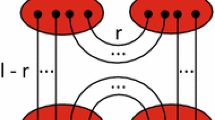Abstract
In previous work the authors, using the Bethe Ansatz, found for the N-particle asymmetric simple exclusion process on the integers a formula—a sum of multiple integrals—for the probability that a system is in a particular configuration at time t given an initial configuration. The present work extends this to the case where particles are of different species, with particles of a higher species having priority over those of a lower species. Here the integrands in the multiple integrals are defined by a system of relations whose consistency requires verifying that the Yang-Baxter equations hold.
Similar content being viewed by others
Notes
Many authors consider ASEP on the circle or the lattice [1,L] with open boundary conditions.
This is sometimes called the M+1 species model, empty sites behaving as particles of another species. With our convention, a particle of species M is first-class, having priority over all others.
For example, suppose σ=(3 2 5 4 1), for which B={4,1}. Then the steps might be
$$(1\ 2\ 3\ 4\ 5)\to(1\ 3\ 2\ 4\ 5)\to(3\ 1\ 2\ 4\ 5)\to(3\ 2\ 1\ 4\ 5) \to(3\ 2\ 1\ 5\ 4)\to(3\ 2\ 5\ 1\ 4)\to(3\ 2\ 5\ 4\ 1). $$The only S-factors involving ξ 5 come from steps four and five, and are S(ξ 4,ξ 5) and S(ξ 1,ξ 5).
References
Alcaraz, F.C., Bariev, R.Z.: Exact solution of asymmetric diffusion with N classes of particles of arbitrary size and hierarchical order. Braz. J. Phys. 30, 655–666 (2000)
Alcaraz, F.C., Droz, M., Henkel, M., Rittenberg, V.: Reaction-diffusion processes, critical dynamics and quantum chains. Ann. Phys. 230, 250–302 (1994)
Amir, G., Corwin, I., Quastel, J.: Probability distribution of the free energy of the continuum directed random polymer in 1+1 dimensions. Commun. Pure Appl. Math. 64, 0466–0537 (2011)
Arita, C., Kuniba, A., Sakai, K., Sawabe, T.: Spectrum of a multi-species asymmetric simple exclusion process on a ring. J. Phys. A, Math. Theor. 42, 345002 (2009) (41 pp.)
Arita, C., Ayyer, A., Mallick, K., Prolhac, S.: Recursive structures in multispecies TASEP. J. Phys. A, Math. Theor. 44, 335004 (2011) (27 pp.)
Baxter, R.J.: Exactly Solved Models in Statistical Mechanics. Academic Press, London (1982)
Cantini, L.: Algebraic Bethe ansatz for the two species ASEP with different hopping rates. J. Phys. A, Math. Theor. 41, 095001 (2008) (16 pp.)
Derrida, B., Evans, M.R.: Bethe ansatz solution for a defect particle in the asymmetric exclusion process. J. Phys. A, Math. Gen. 32, 4833 (1999) (18 pp.)
Ferrari, P.A., Fontes, L.R.G., Kohayakawa, Y.: Invariant measures for a two-species asymmetric process. J. Stat. Phys. 76, 1153–1177 (1994)
Golinelli, O., Mallick, K.: The asymmetric simple exclusion process: an integrable model for non-equilibrium statistical mechanics. J. Phys. A, Math. Gen. 39, 12679–12705 (2006)
Humphreys, J.E.: Reflection Groups and Coxeter Groups. Cambridge University Press, Cambridge (1990)
Kardar, M., Parisi, G., Zhang, Y.-C.: Dynamic scaling of growing interfaces. Phys. Rev. Lett. 56, 889–892 (1986)
Liggett, T.M.: Coupling the simple exclusion process. Ann. Probab. 4, 339–356 (1976)
Liggett, T.M.: Stochastic Interacting Systems: Contact, Voter and Exclusion Processes. Springer, Berlin (1999)
Liggett, T.M.: Interacting Particle Systems. Springer, Berlin (2005). [Reprint of the 1985 original]
Perk, J.H.H., Schultz, C.L.: Families of commuting transfer matrices in q-state vertex models. In: Jimbo, M., Miwa, T. (eds.) Non-linear Integrable Systems: Classical Theory and Quantum Theory, pp. 137–152. World Scientific, Singapore (1983)
Sasamoto, T., Spohn, H.: Exact height distributions for the KPZ equation with narrow wedge initial condition. Nucl. Phys. B 834, 523–542 (2010)
Tracy, C.A., Widom, H.: Integral formulas for the asymmetric simple exclusion process. Commun. Math. Phys. 279, 815–844 (2008)
Tracy, C.A., Widom, H.: Erratum to “Integral formulas for the asymmetric simple exclusion process”. Commun. Math. Phys. 304, 875–878 (2011)
Wehefritz-Kaufmann, B.: Dynamical critical exponent for two-species totally asymmetric diffusion on a ring. SIGMA 6, 039 (2010) (15 pp.)
Yang, C.N.: Some exact results for the many-body problem in one dimension with repulsive delta-function interactions. Phys. Rev. Lett. 19, 1312–1315 (1967)
Acknowledgements
This work was supported by the National Science Foundation through grants DMS-0906387 (first author) and DMS-0854934 (second author).
Author information
Authors and Affiliations
Corresponding author
Rights and permissions
About this article
Cite this article
Tracy, C.A., Widom, H. On the Asymmetric Simple Exclusion Process with Multiple Species. J Stat Phys 150, 457–470 (2013). https://doi.org/10.1007/s10955-012-0531-9
Received:
Accepted:
Published:
Issue Date:
DOI: https://doi.org/10.1007/s10955-012-0531-9



